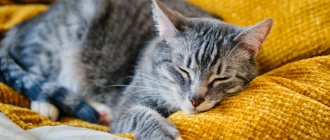11/13/2021 92,465 Diseases and treatment of cats
Author: Olga
When a cat itches or diligently licks itself, this is a completely normal and natural phenomenon. However, animal owners should be wary of their too frequent manifestation, which is accompanied by anxiety and irritability. In this case, often the animal already needs help. Remember that itching is not a disease, but its first symptom, so this manifestation cannot be ignored.
[Hide]
Causes of obsessive licking and gnawing of cats
So, have you noticed that your pet has started scratching, licking and even gnawing itself frequently? This is a clear sign that your cat either has parasites or there are other causes of itching and irritation. The cat will not just constantly lick and scratch himself; this is a defensive reaction to the fact that something is bothering him. Let's consider all possible causes and signs.
Fleas
This is perhaps the most common reason that a cat scratches and licks itself all the time, especially in the area above the tail and on the paws. These parasites can even appear in pets, so no one is safe from them. At the same time, if you do not see small black dots on your cat’s fur, this does not mean that there are no fleas. They can still be very tiny (nits) or simply in the form of eggs on the fur. However, their vital activity will already cause enormous inconvenience and discomfort to the pet.
Other parasites
In addition to fleas, your cat may develop other skin parasites that can cause anxiety and discomfort. The pet will also itch and lick itself a lot. A clear sign of the presence of any parasites is if the cat tries to gnaw something out of its fur. The animal intuitively tries to remove annoying enemies in this way. The most common of them are lice and ticks, which in turn are also dangerous because they carry infections and viruses.
Allergy
If you regularly treat your cat's fur for parasites and the veterinarian's analysis does not show their presence, the cause of the itching may be an allergy. Pedigree cats and cats suffer from it especially often. This may be, like in humans, a manifestation of sensitivity to food, furniture upholstery, or some chemical component. A particularly clear sign of an allergy is when a cat licks itself heavily, thus trying to scratch its nose and lips.
Allergies can be not only to food components, but also seasonal or, for example, to dust and pollen. It is important to get tested and identify the irritating allergen as soon as possible.
Bacteria and fungi
Various microflora live on the skin and in the body of any even healthy animal. But if the cat’s body is weakened, experiencing some kind of stress, lack of vitamins, etc., this can cause an increase in the amount of pathogenic microflora. Because of this, various types of skin inflammation, rashes, itching occur, and the pet’s general condition worsens. Most often, the cause of this phenomenon lies in bacteria and all kinds of fungi. By the way, they can also be transmitted through human hands, because the cat constantly licks itself.
Skin diseases
As a rule, they are all infectious in nature and occur after a pet comes into contact with an infected object. Sometimes it is enough for a cat to go outside just once to pick up some kind of infection. Often, diseases such as pyodermatitis, cheyletiellosis, demodicosis, and scabies occur. They are also caused by mites that parasitize the upper and deep layers of the skin. Severe itching in the first stages very quickly develops into general skin damage and baldness.
If a cat's skin problems are detected, the cat owner needs to thoroughly wash their hands with soap and maintain personal hygiene, since many viruses and bacteria can be transmitted to human hands.
Hormonal disorders
Another of the many reasons why your pet is scratching and licking excessively. As a rule, the cat may experience symptoms of all the previously described causes, for example, baldness, itching, urticaria, and so on. But this is not always due to parasites or diseases. This reaction can be caused by endocrine disruptions, which must be correctly determined by a veterinarian. A therapeutic diet and corrective therapy are prescribed.
Why you can't stop itching
If you have not yet visited the veterinarian, you should not smear the sores with anything at all - this will distort the results of scrapings and tests, which will complicate the diagnosis. You should not immediately offer your animal antihistamines - firstly, you may not guess the dosage, and secondly, the blood test will be invalid.
Once the veterinarian has prescribed medications and ointments, there is no need to relieve itching - most medications already contain substances that reduce discomfort.
Finally, anti-itch medications in humans can cause allergies in cats, which will only make the problem worse.
Treatment
If you notice that your cat is constantly itching, licking itself, and at the same time acting restlessly, hitting its tail, you should immediately take your pet to the veterinarian. It is better not to try to establish the cause and diagnosis yourself, since many of the symptoms are similar to each other. Laboratory analysis and proper examination will be required.
If the reason that the cat is constantly itching, licking and licking itself lies in fleas and other skin and fur parasites, then external treatment is prescribed. The veterinarian may prescribe special drops or sprays, or recommend treating the animal with medicated shampoo. As a rule, using all these drugs several times helps to quickly remove itching and irritation and overcome parasites. In the future, only timely prevention will be required.
If the skin ailment is caused by an infection or fungus, medicinal sprays and drops will also help in the early stages. But, as practice shows, special medications and antibiotics may still be required. If the cat is constantly itching, licking its face, scratching its ears and eyes, antihistamines are prescribed. An accurate analysis is performed and the source of the allergy is determined.
Main symptoms
Some pathological conditions of the skin, which are accompanied by severe itching, are clinically manifested by redness of the skin at the site of the lesion, loss of elasticity and firmness, as well as scratching from the claws of the animal. Since a sick pet is trying to relieve itself of the discomfort that has arisen, it will constantly scratch and lick the itchy areas of the body.
In places of intense itching, wounds from scratching, areas of baldness, and infected scratches are identified. A cat that is bothered by itching must be shown to a veterinarian, who will conduct a series of studies to determine the nature of the underlying disease and prescribe adequate treatment.
Veterinarian advice
It is no secret that many parasites and viruses are transmitted from one animal to another, through the hands of people, but you should not be afraid and limit the freedom of a cat. Of course, there is no need to throw your pet into a pack of stray cats, but letting it out for a walk on the balcony or in the country is quite possible. Like any animal, cats also need fresh air and sun. It is enough just to keep the animal clean and carry out timely antiparasitic treatment.
Do not forget about a proper and balanced diet, which is also the key to your pet’s health. If he has a strong immune system, then no infection will be scary to him. Do not feed prohibited foods, sweets, salty and smoked foods. All this can cause or provoke the occurrence of food allergies. Pay attention to when your pet licks.
And finally, the last piece of advice is love and affection. Remember that your cat is a living creature that needs your care and attention. A change of owner or a change in your behavior can cause stress in your pet. And stress, as you know, is the first step to illness. If you want to pet an animal, but it is nervous and wags its tail, it is better to leave it alone, do not squeeze or pick it up without the desire of the pet itself. Remember that he also has the right to peace and rest.
Sorry, there are no surveys available at this time.
Ringworm and other fungal diseases
The development of fungal diseases is quite difficult to detect, especially at an early stage. As a rule, the owner only realizes it when the disease begins to progress.
Trichophytosis
The second name of the disease is ringworm. To diagnose, it is enough to examine those places that the pet actively combs. If hair loss is observed, and the bald patches are shaped like circles, then most likely the cat has trichophytosis.
The problem is quite easy to localize and treat. The main thing is not to waste time and prevent the disease from spreading to other parts of the body. Otherwise, all the hair will fall out, and the cat will scratch itself until it bleeds.
Lichen
Important! Ringworm can be transmitted to humans. Treatment in this case is not only long, but also painful. Therefore, you need to check your pet for trichophytosis regularly.
Dermatomycosis
Fungal infections also cause severe itching and burning. For people, dermatomycosis is not dangerous. The treatment is quite specific, so it can only be prescribed by a veterinarian. In advanced cases, the cat itches until it hurts, so it is better not to delay a visit to the doctor.
Video “Cats also love to swim”
Do you think cats don't like to bathe? They love it so much! This video is proof of our words. Moreover, timely and proper bathing will help your pet not only be clean, but also protect it from itching and fleas.
Was this article helpful?
Thank you for your opinion!
The article was useful. Please share the information with your friends.
Yes (81.82%)
No (18.18%)
X
Please write what is wrong and leave recommendations on the article
Cancel reply
Rate the usefulness of the article: Rate the author ( 20 votes, average: 4.45 out of 5)
Discuss the article:
Ticks
Not only fleas, but also dozens of types of ticks interfere with a cat’s life. The most common are Otodectis, which causes otodectosis in the ears, Cheyletella, which affects the skin, and Notoedrus.
- Otodectosis is a disease specific to the ears: the cat purposefully scratches its ears, it is uncomfortable to touch the affected area, and it presses its ears to its head. In the auricle there is “dirt” and many dark grains, serous discharge. Otodectosis is treated with drops in the ears or on the withers, wiping the ears with antiseptics, and sometimes by taking vitamins and immunomodulators.
- Cheyletiellosis is a skin disease; the first symptom, in addition to scabies, is dandruff. Sometimes papules appear covered with scales.
- Notoedrosis affects the face and ears: they become covered with characteristic papules, sometimes spreading to other parts of the body. The affected areas become covered with scabs, the fur falls out, and appears dull and matted. Both cheyletiellosis and notoedrosis are treated by treating the affected areas with veterinary acaricides.
Psychogenic factors
Cat owners underestimate the potential psychogenic causes of itching in an animal. The latter appear during periods of severe stress, for example, in the absence of the possibility of mating. In this case, the pet may not only constantly itch, but also mark its territory, behave aggressively, refuse to eat food, and tear furniture with its claws.
There are several ways to solve the problem:
- Organization of mating;
- Castration of an animal;
- Using special sedatives for cats.
Hormonal imbalances that cause scratching
Excessive itching due to hormonal imbalances is a fairly common phenomenon, especially characteristic of purebred animals and not associated with fleas.
Thyroid dysfunction
If the thyroid gland is dysfunctional (hypothyroidism), the cat's skin begins to itch and itch, hair falls out intensively, and dandruff appears, which is not associated with exposure to fleas.
Cushing's syndrome
Caused by problems with adrenal function. It manifests itself as alopecia on the sides and along the back, the skin becomes thinner, dries out, and cracks form, causing the spread of external infection.
Prevention measures
- Limit your indoor cat's contact with street animals. At the same time, do not deprive her of fresh air: you can let your pet out onto the balcony or into a fenced-in space, for example, in the country.
- Timely treat your pet against external (fleas, ticks) and internal (helminths) parasites.
- Inspect the animal's fur and skin.
- Provide a balanced diet and avoid consuming foods that cause allergic reactions.
- Cats feel the manifestation of love and care from humans. You should not allow your pet to experience stress. Any worries and neuroses are the first step towards the development of diseases.
- Regular visits to the veterinary clinic .
[custom_ads_shortcode1]
Why is itching dangerous in a cat that is not affected by fleas?
If your cat is constantly licking itself and scratching continuously for several days, then it needs immediate treatment. After all, a careless bite can cause a serious infection in small wounds. First of all, you need to check whether fleas or other parasites are visible to the naked eye. If there are no signs of infection, you should urgently consult a veterinarian.
Only a professional will determine the true causes of the problem, which may include:
- scabies;
- demodicosis;
- notoedrosis;
- pyoderma;
- ear infections.
Features of treating itching in a cat, depending on the initial trigger
In order to successfully eliminate cat itching, it is first necessary to determine the main cause that provoked irritation of the pet’s skin. Only after eliminating the trigger (disease provocateur) can you think about how to treat the itching itself and its consequences.
To speed up the healing of your pet's combed skin, you can use vitamin E in liquid form. You can also put a special Elizabethan collar on the animal, which will prevent further scratching of the wounds.
If the animal cannot get used to the presence of a protective structure on the neck, then you can sew a T-shirt that will protect 90% of the body. Already combed wounds must be disinfected with regular iodine.
Veterinarians also usually recommend using the following natural remedies to speed up wound healing:
- liquid honey;
- silver water;
- lavender essential oil diluted with coconut oil;
- tinctures of St. John's wort or calendula (preferably non-alcoholic).
Of course, immediately after applying any product, the cat will try to lick it off. It is for this purpose that doctors recommend purchasing a protective collar in advance, or sewing any barrier cape yourself. It is also worth carrying out preventive anti-flea treatment on the animal, even if no signs of parasites were noticed with the naked eye. Bathing with a special shampoo will not only not harm the cat, but will also relieve the itching for a while.
You can help your animal cope with unpleasant sensations using a homemade decoction of rosemary and peppermint. A simple rinse with this natural product will create a feeling of coolness, which will allow your pet to calm down for at least a few hours. It is also necessary to force your pet to drink a lot of water: sometimes excessive dry skin is caused by a lack of fluid in the diet.
Special diet
During treatment, dietary products are selected for the cat, the consumption of which reduces the intensity of itching and the likelihood of relapses. Your cat's daily diet should be balanced. It is not recommended to give smoked and sweet foods.
Adviсe:
- If the cat was eating food before the allergy appeared, then purchase a hypoallergenic variety.
- When a cat is fed regular food, pork, potatoes and porridge are removed from the diet. They give fish, butter and vegetables.
- Adding fish oil to food (tuna, salmon, sardines, anchovy) helps reduce itching.
Timely adjustment of the diet and daily monitoring of the animal’s condition are required.
Diagnosis of scratching
There are many reasons why a cat may scratch. Minor allergies, parasites, fungi and even some diseases of the internal organs can lead to the fact that the pet begins to scratch itself until there are bloody wounds. Determining the exact cause of such a violation can sometimes be very difficult. In most cases, it is impossible to do without the help of a veterinarian and numerous tests.
Veterinarians distinguish two types of scratching:
- Local. Appear in one or more places. The muzzle, neck and withers are most often affected.
- Generalized . The cat scratches its entire body until it bleeds.
Without proper and timely treatment, the local type may well become generalized.
Most often, lichen infection leads to scratching. This is a disease contagious to humans. That's why you shouldn't ignore it if your pet suddenly starts itching a lot. Diagnosing a lichen infection is quite simple: almost any veterinary clinic has a Wood's lamp, under which the fungus will appear.
If not, you will need to take a skin scraping. Hairs and skin flakes should also be examined. The fungus is often complicated by a bacterial infection.
Information needed to be collected:
- when exactly did the cat start itching?
- with whom and what did she contact before;
- whether other symptoms of the disease appeared.
Itching can appear as a result of an allergic reaction to new food, pollen, or flea bites. There are especially advanced cases when an animal is allergic to dust.
The easiest way to identify food allergies is by introducing new foods into your diet one by one. But only tests will help determine non-food allergies.
Severe stress can also lead to itching. In this case, it is impossible to diagnose it in a clinical setting.
Sometimes skin problems are one of the symptoms of internal organ disease. In this case, you will have to conduct a full diagnosis of the pet’s health condition. To do this, the following research should be carried out:
- general blood analysis;
- fecal analysis for helminths;
- Ultrasound of internal organs;
- skin biopsy.
Inflammatory processes that cause cats to itch
An obvious pathological factor that provokes constant itching of the skin in an animal is an active inflammatory process. It can be both local and systemic. The most well-known diseases in cats accompanied by an inflammatory process:
- Otitis. If this disease is present, the cat constantly scratches its ears and is very irritable because it suffers from severe pain. The solution to the problem will be the use of drugs that reduce the intensity of the inflammatory process in the designated location;
- Pyoderma. Pyoderma in animals is manifested by purulent inflammation of the skin provoked by coccal bacteria. The cat's epithelium is deeply affected and cannot be treated with local remedies: antibacterial therapy is required under the mandatory supervision of a veterinarian;
- Secondary bacterial infections. They occur after insufficient aseptic treatment of wounds, cuts, and surgical sutures. Treated with broad spectrum antibiotics.










